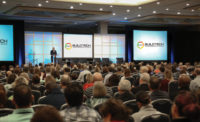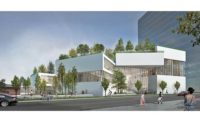And it's not simply about cutting energy use or using environmentally friendly materials.
"Sustainability now encompasses the well-being of a building's users and making the experience as healthy and responsive to their needs as possible," Dunlap says. "Clients also want us to understand their company culture, then reinforce it in the physical environment. And it's not an add-on; it's a necessity."
High-Tech Collaboration
Understanding a client's culture is particularly critical in the high-tech sector, where firm identity is crucial to attracting and retaining top talent.
For its new Santa Clara headquarters, visual computing technology company Nvidia wanted a distinctive facility that reflected its core belief in people as its greatest asset. Gensler's answer: a 250,000-sq-ft triangular building with interior spaces designed to foster both impromptu employee interactions and more focused work.
Gensler also took the concept of client collaboration a step further for the $200-million project currently under construction, utilizing Nvidia's technology products to fine-tune the size and shape of the pyramid roof structure, maximizing its responsiveness to sunlight and wind.
"Clients expect us to work as fluidly with technology as they do," says Joan Price, managing director of the design firm's San Francisco office. "That sets the stage for co-creation and co-innovation, which we will see more of in the Bay Area."
Continually meeting these changing demands across multiple markets requires a high degree of creativity. Gensler employs a variety of idea-stimulating tools, including office-wide charettes, presentations by third-party thought leaders and the company's internal Design Excellence Awards program, which is reviewed and critiqued by jurors representing a mix of clients, academics, journalists, critics and other designers.
Equally important, says Jernigan, is encouraging a culture of exploration and risk-taking among staff members, particularly those new to the team.
"Because California has a relatively short history compared with the rest of the country, we tend to focus more on looking ahead than trying to replicate the past," he says. "And clients want us to help move them forward by involving them in the process, not simply throwing a solution at them."
The client-consultant collaboration is perhaps most critical when a project encounters more than the typical "bumps in the road."













Post a comment to this article
Report Abusive Comment